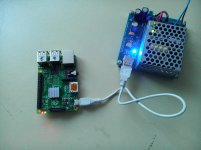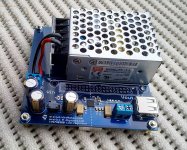Hi guys,
lately I was busy with building regulator for Raspberry Pi 2 player. It is based on TPS7A8300. Because 8300 has very low max voltage input, 6.5V, I used Meanwell RS-15-5 to convert 230AC voltage down to 5.6V DC. Another reason why I used Meanwell transformer is its size. Total regulator dimensions are 92mm x 82mm x 40mm. If one does not want to use this type of transformer, PCB is breakable so the size of it can be reduced. On the output side I used PCB screw terminal, for so called invasive mode of connection and USB type A female connector for noninvasive mode. How it performs in term of sound I can't say much as I am still waiting for I2S DAC board. Once altogher connected I'll report.
Best Regards,
Aleš
lately I was busy with building regulator for Raspberry Pi 2 player. It is based on TPS7A8300. Because 8300 has very low max voltage input, 6.5V, I used Meanwell RS-15-5 to convert 230AC voltage down to 5.6V DC. Another reason why I used Meanwell transformer is its size. Total regulator dimensions are 92mm x 82mm x 40mm. If one does not want to use this type of transformer, PCB is breakable so the size of it can be reduced. On the output side I used PCB screw terminal, for so called invasive mode of connection and USB type A female connector for noninvasive mode. How it performs in term of sound I can't say much as I am still waiting for I2S DAC board. Once altogher connected I'll report.
Best Regards,
Aleš
Attachments
-
 TPS7A8300_pcb (1).jpg466.2 KB · Views: 1,804
TPS7A8300_pcb (1).jpg466.2 KB · Views: 1,804 -
PCB.pdf37.9 KB · Views: 291
-
schematic.pdf17.1 KB · Views: 519
-
 IMG_20150424_171739.jpg813.3 KB · Views: 731
IMG_20150424_171739.jpg813.3 KB · Views: 731 -
 IMG_20150424_171953.jpg839.2 KB · Views: 538
IMG_20150424_171953.jpg839.2 KB · Views: 538 -
 IMG_20150424_171935.jpg703.3 KB · Views: 1,626
IMG_20150424_171935.jpg703.3 KB · Views: 1,626 -
 IMG_20150424_171903.jpg712.1 KB · Views: 1,879
IMG_20150424_171903.jpg712.1 KB · Views: 1,879 -
 IMG_20150422_195808.jpg751.2 KB · Views: 1,692
IMG_20150422_195808.jpg751.2 KB · Views: 1,692 -
 IMG_20150422_195930.jpg957.6 KB · Views: 1,778
IMG_20150422_195930.jpg957.6 KB · Views: 1,778
Two days ago I tried Odac with raspberry pi, alltogher powered by the TPS7A8300. I was running headphones T51p directly from Odac and I must say the first impression is really good.
Just a few more word about the circuit. In pre regulator stage there is CLC filter. It is build from three Panasonic FC 1000uF/10v capacitors with common mode choke from TDK, ACM7060 series. This choke is small but it can withstand up to 5A of current, which is more than enough for this application. PCB itself is made by following apllication design.
On this PCB I am also planning to use heatbridge as I did used it in my TP7A4700 design. This will provide very good heat dissipation and ensure low temperature for PCB and components on it, leading to the expansion of their lifetime.
Best Regards,
Aleš
Just a few more word about the circuit. In pre regulator stage there is CLC filter. It is build from three Panasonic FC 1000uF/10v capacitors with common mode choke from TDK, ACM7060 series. This choke is small but it can withstand up to 5A of current, which is more than enough for this application. PCB itself is made by following apllication design.
On this PCB I am also planning to use heatbridge as I did used it in my TP7A4700 design. This will provide very good heat dissipation and ensure low temperature for PCB and components on it, leading to the expansion of their lifetime.
Best Regards,
Aleš
Looks good!
How much was that Meanwell PSU? It says it puts out 5V, not 5.6 though?
Did you solder the TPS7A8300 yourself?
How much was that Meanwell PSU? It says it puts out 5V, not 5.6 though?
Did you solder the TPS7A8300 yourself?
Thanks. This series of Meanwell PSUs have adjustable output, ranging from 4.4V to 5.6V. 0.6V is enough voltage drop for TPS7A8300. It costed around 15€ in local shop, but on the web can be found for around 10€. I soldered this qfn chip using stencil and reflow owen.
Best regards,
Aleš
Best regards,
Aleš
Hi Aleš, will you be providing PCBs for this design? I see you sell the completed unit on eBay but I was wondering if you were going to offer a more DIY solution to diyAudio members. It is exactly the power supply I need for my Raspberry Pi/DAC project.
Hi Aleš, will you be providing PCBs for this design? I see you sell the completed unit on eBay but I was wondering if you were going to offer a more DIY solution to diyAudio members. It is exactly the power supply I need for my Raspberry Pi/DAC project.
Hi James,
do you mean PCB only or with components? It is hard to offer more DIY solution because QFN chip and other SMD components are hard to solder for many diyers. If you are looking for this PCB (with components) without Meanwell PSU you can contact me via PM.
Best Regards,
Aleš
I've been enjoying very much a music produced by a RPi 2 + ODAC combo with this LDO put behind . Compact, versatile design btw. Good work, Ales!
My only wish is this board would have an optional usb isolation section on the very same board (this still comes handy on a couple of occasions)
My only wish is this board would have an optional usb isolation section on the very same board (this still comes handy on a couple of occasions)
Hi forta,
I am glad you like it. I could make USB isolator, but the real question is what IC to select. Which one would be easy to implement while still providing great performance.
Best Regards,
Aleš
I am glad you like it. I could make USB isolator, but the real question is what IC to select. Which one would be easy to implement while still providing great performance.
Best Regards,
Aleš
Hi Aleš, I use my own fully linear SBT PSU (originally intended for always-on operation as with SB Touch devices) for the Raspberry Pi 2 since that one also needs 5V DC. Results are excellent but I find the need for a power button that powers the Raspberry Pi and its display on and off by means of a power button. For this purpose i ordered an ATXRaspi today as development costs for just one PCB are simply too much to make one myself. It also can reboot the RPI and it has nice LED functions. I see TPS7A8300 also has an Enable pin, maybe you can use that one for controlled power on/off too. Just an idea for extra functionality specifically for the RPI.
ATXRaspi | LowPowerLab
ATXRaspi | LowPowerLab
Last edited:
Hi jean-paul,
it sounds like a great idea. I could make pin header for enable pin and add on PCB for reset and power on/off button. Have you maybe tried the script that can be found on ATXRaspi site with volumio os?
Best Regards,
Aleš
it sounds like a great idea. I could make pin header for enable pin and add on PCB for reset and power on/off button. Have you maybe tried the script that can be found on ATXRaspi site with volumio os?
Best Regards,
Aleš
Not yet as I only ordered ATXRaspi yesterday. BTW Both with your PSU as with my own PSU the PSU will be powered on continuously. A small transformer keeping the electronics powered and that switches on the (in your case switched) PSU with a relay would also be an eco/green solution. Just some ideas, I toyed with the idea myself but choose to focus on the Squeezebox Touch, DACs and such and definitely want to keep it linear. Point is that switching 230 V AC does not work optimally with RPI. RPI needs to have a clean shutdown sequence.
Last edited:
May I suggest to turn the output screw terminal 90 degrees so that it can be used simultaneously with the USB connector ?
BTW in my previous post I mentioned switching on the Meanwell PSU with a relay but an SSR would even be better as it can be switched on and off with LED-like voltage and current.
SSR could be this one:
http://nl.farnell.com/clare/pd2401x2/ssr-pcb-mount-240vac-1-4v-1a/dp/2292967
Or this one:
http://nl.farnell.com/sharp/s202t02f/relay-solid-state/dp/1618478
Mini transformer:
http://nl.farnell.com/myrra/44049/transformer-6v-1va/dp/1689041
BTW in my previous post I mentioned switching on the Meanwell PSU with a relay but an SSR would even be better as it can be switched on and off with LED-like voltage and current.
SSR could be this one:
http://nl.farnell.com/clare/pd2401x2/ssr-pcb-mount-240vac-1-4v-1a/dp/2292967
Or this one:
http://nl.farnell.com/sharp/s202t02f/relay-solid-state/dp/1618478
Mini transformer:
http://nl.farnell.com/myrra/44049/transformer-6v-1va/dp/1689041
Last edited:
If there will be next revision of the PCB I will definately turn the screw connector for 90°. I was also thinking to add 40pin speedy connector, supplying Rpi through GPIO and also to connect on/off and reset GPIO's. When I'll have something ready I'll post it.
To make it more green and eco I would use this transformer http://si.farnell.com/vigortronix/vtx-214-001-105/ac-dc-conv-fixed-1-o-p-1w-5v/dp/2401020 and one of SSR relays you proposed.
Best Regards,
Aleš
To make it more green and eco I would use this transformer http://si.farnell.com/vigortronix/vtx-214-001-105/ac-dc-conv-fixed-1-o-p-1w-5v/dp/2401020 and one of SSR relays you proposed.
Best Regards,
Aleš
For reliability (always connected to 230 V) I would not use a switcher for that. Most manufacturers seem to think the same, I mostly see small mini transformers for that goal. They consume very little power.
As if one switcher is not bad enough already 😉 Just joking.
I like the idea of a 40 pin connector. It will ditch the micro USB connector for powering the Pi.
As if one switcher is not bad enough already 😉 Just joking.
I like the idea of a 40 pin connector. It will ditch the micro USB connector for powering the Pi.
Hello Jean-Louis,
Nothing smart yet for Rpi 2. But I am preparing something for Rpi Zero.
Best Regards,
Aleš
Nothing smart yet for Rpi 2. But I am preparing something for Rpi Zero.
Best Regards,
Aleš
hi ales
is this PSU solely for powering the pi ? would it have other outputs, say to power a USB hub or a sata drive ?
dc
is this PSU solely for powering the pi ? would it have other outputs, say to power a USB hub or a sata drive ?
dc
Hi dearchap,
you can power anything with this power supply as long as it fits the specs, 5V 2A. The last version had USB connector, screw terminal and Raspberry pi pin header, so that many different devices could be plugged on to it.
Best regards,
Aleš
you can power anything with this power supply as long as it fits the specs, 5V 2A. The last version had USB connector, screw terminal and Raspberry pi pin header, so that many different devices could be plugged on to it.
Best regards,
Aleš
Attachments
- Status
- Not open for further replies.
- Home
- Amplifiers
- Power Supplies
- Raspberry PI PSU with TPS7A8300 5V 2A
